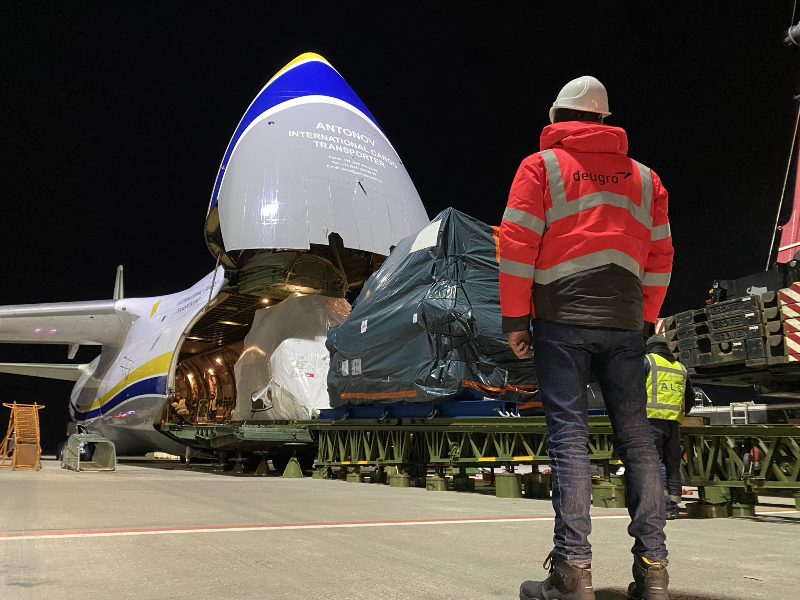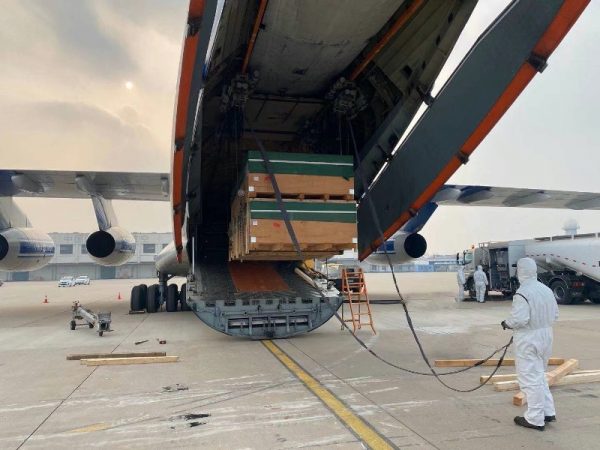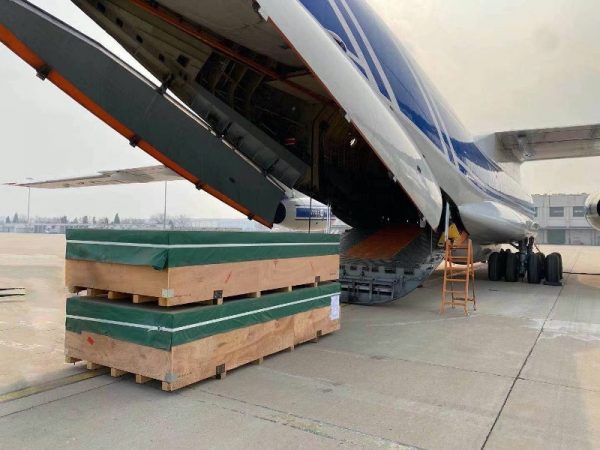Air cargo energy logistics: Up and coming
05 / 07 / 2021

Covid’s impact saw many energy projects suspended or postponed, but the market’s specialist logistics providers are already recharging their batteries for post-pandemic demand.
The sudden and significant decline in bellyhold capacity due to Covid drove up the rates for freighter flights, mainly for general cargo but with some effect on heavylift charters.
The later use of cargo-only passenger aircraft eased that pressure, but rates remained high.
Valds Stunza, development manager at project specialist Eleven Danir19, says that ongoing major energy projects cannot suddenly be put on hold: “We deal with what we have, to support and provide the industry with everything it needs, despite the difficulties and rates increase. It’s just became a daily routine.”
The sudden need for PPE transport and lower airfreight capacity had a double whammy effect. Mustafa Sener, global head of project logistics at global forwarder Kuehne and Nagel (K+N), says: “That combination caused a major spike in transportation costs overall, with major projects still on hold until further notice.”
Pavel Kuznetsov (below), head of air chartering at deugro, the specialist freight forwarding and project logistics solutions operator, says bellyhold has always been an optimal solution for some dense energy cargo with relatively compact dimensions because “the rates are attractive, and the service is reliable”.

He adds: “Bellyhold freight and heavylift capacity are not two isolated markets. As we observed last year, they are very closely connected and the drastic reduction in bellyhold capacity created a domino effect in the whole market.”
Commodities normally moved on the lower deck spilled over to maindeck capacity.
The spike in demand for Covid-related products such as PPE, virus tests, vaccines and vaccine production equipment, plus the rapidly growing e-commerce market, led to extreme capacity shortages.
This, continues Kuznetsov, led to a situation where “any or every possible aircraft capacity was exploited and ramp aircraft such as the AN-124 and IL-76 – usually used for heavily and outsized cargo – were charted in the urgent transport of general cargo”.
That demand led to higher rates, making heavylift aircraft economically viable for smaller consignments.
Covid restrictions also saw energy production plants shut down and cross-border movements subject to volatile government rules and regulations, making supply chain planning ever more challenging for moving rotors, diesel generators, transformers for power generation and equipment for oil and gas installations.
Kuznetsov at deugro says that Covid saw decisions on new energy projects “slow down significantly” and some previously approved projects were put on hold, and those projects that continued “faced more challenging conditions in which staying on track has been much more difficult”.
Kuznetsov, whose heavylift experience includes 12 years with Volga-Dnepr, identifies two main Covid factors: “The first impact was on production, and the various restrictions introduced by countries around the world forced many production lines to shut down for a certain period or some were functioning with limited capacity. The output of goods has been delayed in many cases, but projects need to keep on track and there can be no excuses.”
Modal shift
Another factor identified by Kuznetsov was the impact on traditional supply chain modes, not helped by a stranded mega boxship in the Suez Canal: “In seafreight there is a capacity shortage, an equipment imbalance and port congestion. All that creates a huge amount of uncertainty in which sea clients use airfreight solutions as something which allows them to keep their schedules intact. We saw significant demand for modal shift from sea to air.”
Stunza at Eleven Danir19, agrees: “This is a really tough and challenging time for the logistics industry. I believe the supply chain is at its capacity limit, but still working.
“The fact that we have managed to withstand the pressure and not allowed the supply chain to be broken shows that logistics companies dealt with the stress were able to adapt to new problems and offer the most profitable and suitable solutions to their partners and clients.”
Sener at K+N observes that multipurpose ocean vessels, used to transport ‘high and heavy’ installations, are now feeling the pinch, and this could in the short term mean switch to airfreight: “In the last three to four months many multipurpose vessels moving heavyweight cargo across the globe have become a major bottleneck, with many vessels completely overbooked and not having enough capacity for the demand in the market for existing projects.”
He adds that the multipurpose sector has seen vessel operators now request that customers decide on a rate offer within 24 hours, rather than the usual three to four weeks: “We are coming to a point in the industry were a lot of projects, especially those in the renewables, oil and gas and LNG sectors, have shortened timelines and if those deadlines are not met, then [construction and installation] companies will face certain penalties.
“In order to avoid those penalties, there is now a potential discussion that, for some wind energy projects, certain cargo unable to move by sea will fly on suitable aircraft, if possible.”
Stunza believes that no one expected such dramatic supply chain consequences when Covid first appeared, which saw “completely different approaches, and unpredictable decisions by countries to close or open borders, bringing irreparable damage to the industry.
“All this led to an incredible workload for finding new, fresh solutions for all large and small projects. And they also endangered the upcoming and planned works.”
Energy projects are not alone in the knock-on effect from the pandemic.
Impact of the pandemic
Kuznetsov observes: “In general, we have seen a significant effect on capital investment in global projects across multiple industries, and the project landscape is now quite different to pre-Covid. Many investors and operators are now much more cautious in their commercial spending and risk-taking in general.
“It is a similar in pattern to what we saw after the 2015 oil crisis when the recovery was going slowly and started with the lower risk projects. But as those move forward, they create opportunities for the project cargo industry and that in turn builds some confidence in the market.
“Hopefully, that is going to create a base for bigger projects to kick in.”
Kuznetsov cautions that current volatility and capacity issues with both ocean and airfreight markets are hampering greenlight decisions for new projects: “There is a lot of uncertainty that we and our clients face in risk assessment for logistics costs. This is a challenge, but we collaborate to help manage those risks down.”
As the oil and gas industry continues to be affected with both relatively low demand and low oil prices, deugro is focused on its future portfolio which will probably see investment momentum in lower carbon projects and renewables infrastructure in the post Covid world.

Stunza at Eleven Danir19 says that supply chain interruption in any industry, especially in the power and energy sector, can mean huge losses: “We fully understand that this is not acceptable for our clients, and we are always looking for alternative solutions.
“We book charter aircrafts – we change routes, and still carry the necessary cargo. Regardless of the industry, and challenges we face.
“The booking of a full aircraft might be an expensive solution, but it’s definitely worth it comparing the possible losses of cargo not delivered on time.”
Stunza cites the example of a hydro power plant in Kyrgyzstan that had 43.4 tonnes of equipment stuck at a border.
Prompt booking of an IL-76 charter saw delivery from China to Kyrgyzstan in less than 26 hours, despite challenges in loading procedures and preparations.
What are the expectations for the energy logistics sector as the world eases out of Covid?
Says Kuznetsov: “We don’t have a crystal ball, but if I can make any cautious forecasts, then we definitely expect to see further gradual development of the energy market moving away from fossil fuel and in the direction of sustainable energy.
Going greener
“It is not going to happen overnight, but we expect dynamic growth, and this will require huge investment in many mega-projects to support the long-term transition to renewable energies, which many leading countries have committed to.
“These projects will face massive challenges but will definitely present a lot of opportunities for experienced supply chain partners who have the know-how and the understanding of such industries.”
deugro believes that in the interim, a transitional fuel – liquefied natural gas (LNG) – will gain importance, and here deugro has an expanding track record supporting huge LNG projects in Russia, Mozambique the US, and Canada.
Kuznetsov says: “The strongest demand we have seen this year and in the previous year for airfreight solutions was from clients involved in LNG projects. This is something that is definitely on our radar.”
Will ocean freight gain market share from airfreight in the energy sector? For Stunza at Eleven Danir19 the container shortage and huge rate increases in ocean freight saw customers search for different solutions, and airfreight in some cases became the only alternative.
“It keeps being one of the four main transportation options, but it has started to lose its benefits and alternative modes became more reasonable. I can’t say that ocean freight is really losing its market share, but it took one step backwards from becoming an additional piece of the supply chain pie.
“In the current situation, I believe that air logistics solutions are benefiting from the lack of alternatives.
“In most routes and situations, it was not even considered, but now we always keep it in mind. Clients understand that and are starting to feel more comfortable with cargo on an aircraft, enjoying the benefits of this mode of transport.”

Looking further ahead, beyond Covid, to an energy logistics sector influenced by public demand for less fossil fuel and carbon-neutral supply chains, Sener of K+N believes that seafreight solutions will increasingly gain relevance.
“The energy companies are themselves going through a major transition, in how and where they can reduce their carbon footprint, and that includes their logistics.”
He makes the point that, currently, there are now fewer carbon CO2 emissions contributed by seafreight than airfreight and that this will be a “significant consideration” when planning the logistics of future energy projects.
“The planning of those energy logistics projects will definitely be more efficient and better planned.
“The use of ad hoc or out of scope, last-minute airfreight will be quite significantly reduced planners become more mature in sticking to their schedules which is nearly always based on seafreight and ocean transportation.”
Logistics solutions will be calculated with longer lead times, says Sener, using the sea and ocean-based options when planning an energy project.
This trend, he says, is already noticeable in discussions about hydro-energy projects: “The majority are focused on seafreight and on even longer lead-times, as well as bringing the manufacturing closer to the sites.”













